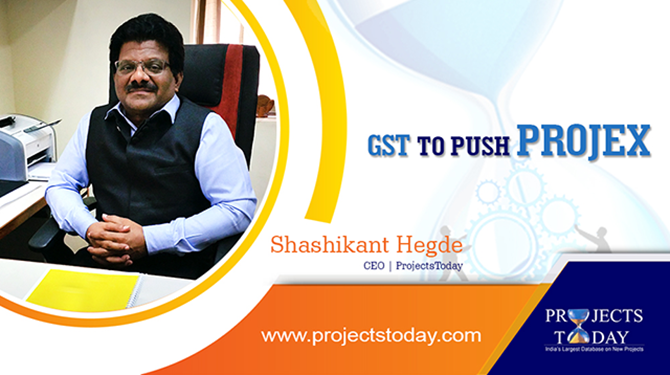"GST to push Projex" - Mr. Shashikant Hegde, CEO, Projects Today
 The central government is all set to roll out the GST from 1 July, 2017. We have read enough on the benefits of GST. Indian corporate captains, economists and institutions like IMF have hailed the decision of the NDA government to implement the much talked about GST. One of the positive impact of GST is, the fall in capital input prices is expected to revive the slowed down projex (projects expenditure).
The central government is all set to roll out the GST from 1 July, 2017. We have read enough on the benefits of GST. Indian corporate captains, economists and institutions like IMF have hailed the decision of the NDA government to implement the much talked about GST. One of the positive impact of GST is, the fall in capital input prices is expected to revive the slowed down projex (projects expenditure).
Presently, companies sourcing capital goods for capacity expansion cannot claim tax credit on capital goods purchased. Under the GST regime they can. This step is expected to reduce the capital goods inputs cost by around 12 to 14 percent. Reduced project cost means more investment. NCAER study indicates that this measure will push the GDP by at least 0.5 percent.
At present, Indian companies with pan India presence have to deal with multiple taxes collected by different agencies with their own rules and compliance requirements. This has resulted in an increase in prices of end products and has also slowed down the pace of movement of goods from the point of manufacturing to the point of distribution.
GST aims to do away with all these. Under GST there will be one tax and a centralised collecting agency. No double taxation. Further, to avail tax credit on the inputs the manufacturers have to ensure that the input suppliers have paid their tax. This means addition of more input suppliers into the tax net.
Way back in 2009, the then Finance Commission had authorised a study by NCAER to assess the impact of GST on growth and exports. The study explored the impact of direct tax reduction on goods and services as well as cost of capital inputs. It concluded that GST, if implemented at its purest form, would push the exports by around 10 to 14 percent and increase the GDP by 2 to 2.5 percent. The study also noted that to be effective, the single rate should not be too high.
Some economists are sceptical about the claims of benefits of GST, but most agree that in the long term, single tax regime will widen the tax bracket, increase the efficiency of the supply chain, and increase the bottom lines of companies, thus leading to increased project investment, more consumption and higher GDP.
Under GST regime, taxes would be levied both by the state and the central governments on supply of goods and services. Both the Central and States will simultaneously levy GST across the value chain. Tax will be levied on every supply of goods and services. Centre would levy and collect Central Goods and Services Taxes (CGST) and states would levy and collect the State Goods and Services Tax (SGST) on all transactions within a State.
There would be four tax rates namely 5 percent, 12 percent, 18 percent and 28 percent. Besides some goods and services would be under the list of exempt items. The threshold exemption limit would be Rs 20 lakhs. For special category States enumerated in article 279A of the Constitution, threshold exemption limit has been fixed at Rs 10 lakh.